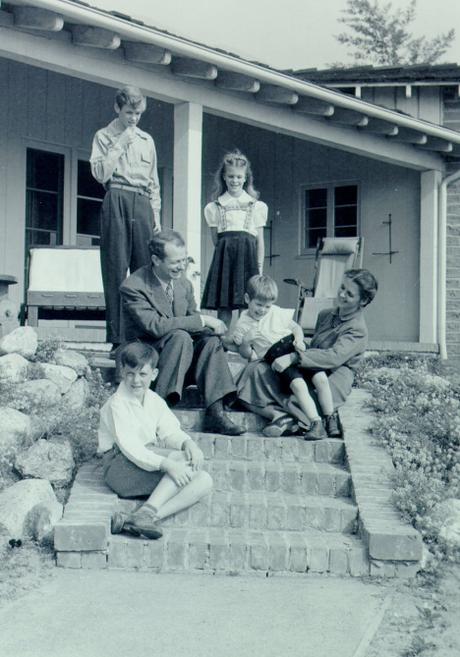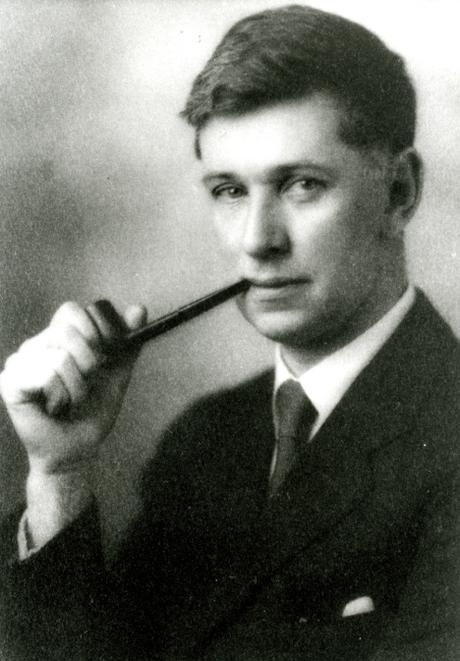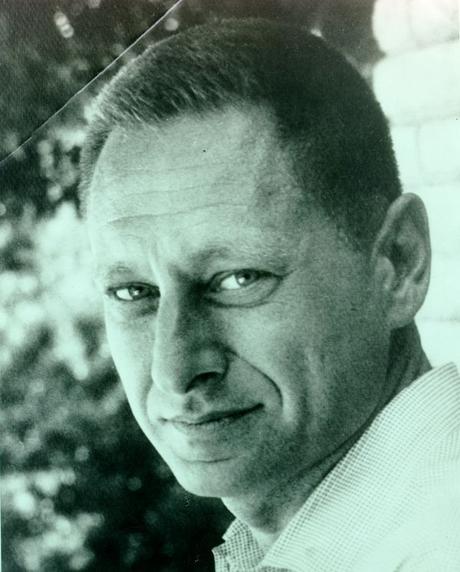 Pauling family portrait taken in 1941. Back of photograph is annotated, “1941. Daddy very ill.”
Pauling family portrait taken in 1941. Back of photograph is annotated, “1941. Daddy very ill.”[Pauling and the Guggenheim Foundation]
In 1941, Linus Pauling’s second year on the Committee of Selection for the John Simon Guggenheim Memorial Foundation, he developed a serious renal disease, glomerulonephritis, that often proved fatal. The onset of this disease emerged during a period of travel that coincided with the Committee’s second meeting of the year, on March 8th and 9th. The night before the first meeting, swelling in Pauling’s face became so pronounced that he was forced to acknowledge it during his acceptance speech for the William H. Nichols Medal, granted to him by the New York Section of the American Chemical Society. In his remarks, Pauling joked
I am happy also that this occasion has brought me in touch with many old friends – with Paul Emmett and Joe Mayer and many others. Several of them said to me tonight that I appeared to be getting fat. This is not so. You know, when I was a boy in Oregon I used to go around a great deal in the green, damp Oregon woods, and I always came into contact with poison oak, which caused my face to swell and my eyes to swell shut, and me to apply so much lead acetate solution that it is a wonder that I didn’t die of lead poisoning. Yesterday I must have bumped into something similar, for my face began to swell, and I began to be afraid that I would have to speak here tonight with my eyes swollen shut – which I could have done, with the practice I have had speaking in the dark.
Well, while I was wondering what the responsible protein could have been, I decided that it was a visitation – that I was being punished for thinking wicked thoughts. The other day I said “It is too bad that something doesn’t happen to Senator Wheeler [Anti-interventionist Senator Burton Wheeler] – nothing serious, just something that would lay him up with his eyes shut for two or three weeks” and my wife said “No what you want is something that would keep his mouth shut – his eyes are closed already.”
After speaking with physicians from the Rockefeller Foundation who were able to properly diagnose him, Pauling made plans to see Thomas Addis, a renal disease specialist at Stanford. He did not, however, beg out of the Committee of Selection meetings, though he left immediately afterwards.
Once Pauling made it back to Pasadena, he was peppered with letters from Guggenheim Foundation Secretary Henry Allen Moe, who wanted Pauling’s input on applicants but, more pressingly, urged Pauling to take care of himself. Following a heavily restricted diet put forth by Dr. Addis, Pauling gradually improved and, by September, reported feeling much better.
Noting this, Moe asked Pauling if he would be interested in traveling to Buenos Aires for six months the following spring to represent the Foundation as a chemist interested in biological questions. Pauling was initially receptive to the idea, writing that it sounded “fun, and perhaps good for me,” but he eventually concluded that he was too busy with war work to seriously entertain the possibility. Though he remained on the Addis diet for quite a long time, Pauling’s most pressing issues with nephritis appeared to be largely behind him. However, five and half years later, Pauling still had to deal with the lingering effects of his poor health.
 Thomas Addis, 1920s
Thomas Addis, 1920sIn March 1947, Linus and Ava Helen were busy planning a trip to Oxford University, where Pauling was slated to begin a tenure as George Eastman Visiting Professor. Pauling had also been invited to receive an honorary doctorate from Cambridge that June. Knowing of these forthcoming travels, Addis suggested that Ava Helen take the lead in finding the couple a residence, one outfitted with kitchen suitable to preparing the types of foods that Pauling would need to stay as healthy as possible. The search proved difficult and was compounded by financial issues that Moe and the Foundation eventually helped to ameliorate.
Pauling’s delicate condition also led Addis to suggest that the Paulings travel across the Atlantic by boat rather than plane. But even with three months to go before their planned departure, arranging passage seemed close to impossible. As options began to run out, Pauling asked Moe if he would contact the British ambassador to the U.S., Lord Inverchapel, to see if any room might be available on a government ship. Moe was happy to do so, explaining Pauling’s situation to the diplomat and emphasizing its significance to the two nations’ scholarly relationship. Inverchapel made no promises in his reply, telling Moe that all routes were fully booked, but that he would place Pauling on a waiting list should anything arise. Pauling thanked Moe for trying, but also noted that the situation was less critical now, as Addis had given him the okay to fly and had placed him on a regimen in preparation.
Before he left for Oxford, Pauling got to thinking about Addis’ nephritis treatment and how well it had worked for him. Pauling thought it better than any other treatment then in use and wanted Addis to speak with researchers in England about it. Addis was eager to do so, but hamstrung by a lack of funding. Pauling relayed the details of Addis’ situation with Frank Aydelotte, the Chair of the Foundation’s Committee of Selection, who suggested that Addis could obtain a Guggenheim Fellowship to support his travel. Secretary Moe, on the other hand, did not think Guggenheim funds to be the best avenue of support and recommended that Addis try the Rockefeller Foundation first. If that did not work out, then Moe promised he would reconsider Addis’ case.
 Richard Lippman, circa 1950s
Richard Lippman, circa 1950sThomas Addis never received a Guggenheim Fellowship, but after he passed away in 1949, his colleague Richard Lippman did. Lippman had worked on renal disease with Addis for two years at the Stanford University School of Medicine in San Francisco, and had also served in the Medical Reserve Corps during the Second World War. After concluding his stint with Addis, Lippman moved south to the Institute for Medical Research at Cedars of Lebanon Hospital in Los Angeles, where he also became Pauling’s personal physician.
With much support from Pauling, Lippman applied for a 1950 Guggenheim Fellowship to go towards the cost of color plates for a book that he had written and to hire an assistant to help him review Addis’ papers. Pauling found Lippman’s proposals “very important in all their aspects” and they ultimately won generous support, including a $3,600 stipend for one year, $1,500 for working with Addis’ papers, and $1,500 towards the publication of his book. (A $500 Dictaphone was not approved.) Lippman received a renewal the following year, garnering another $3,600 to research renal functions and $1,400 to study Addis’ papers.
In 1960, Pauling himself applied for a Guggenheim Fellowship to support his own work, noting in his application that he had “conquered” his nephritis. Moe was very happy to hear this as he still remembered how Pauling had experienced his first acute episode around the time of the 1941 Committee meeting. In the intervening years, Moe helped navigate some of the logistical consequences of Pauling’s illness and Pauling used his own experience with the disease to put forth quality candidates for Guggenheim Fellowships.
